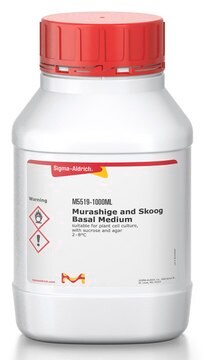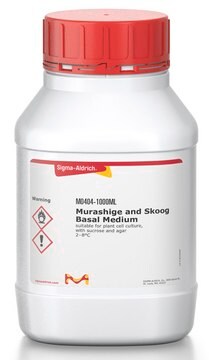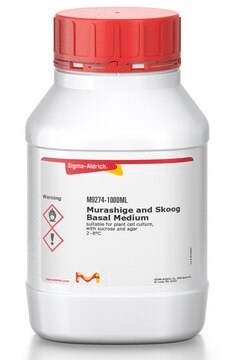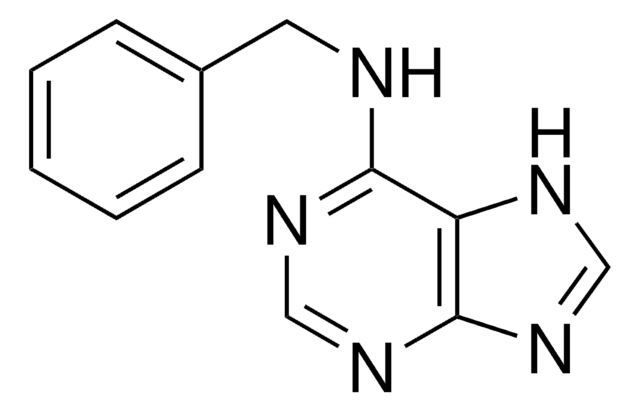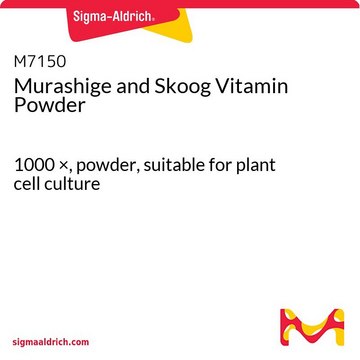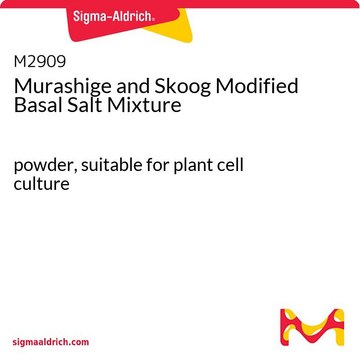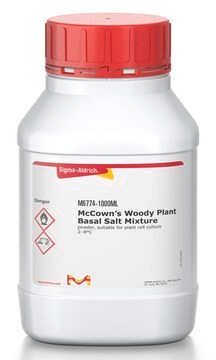M5524
Murashige and Skoog Basal Salt Mixture (MS)
powder, suitable for plant cell culture
Synonym(s):
MS Basal Salts, MS0 Basal Salts, MSO Basal Salts
Sign Into View Organizational & Contract Pricing
All Photos(1)
About This Item
UNSPSC Code:
12352207
NACRES:
NA.72
Recommended Products
form
powder
Quality Level
technique(s)
cell culture | plant: suitable
application(s)
agriculture
shipped in
ambient
storage temp.
2-8°C
General description
Murashige and Skoog medium is a widely used plant tissue culture growth medium. M&S Basal Medium contains macronutrients that include high levels of nitrate and organic additives such as agar, sugars, vitamins and growth regulators. Important growth regulators frequently added to M&S include IAA (auxin/morphogen) and Kinetin (cytokinin/cell division promoter).
Application
Murashige and Skoog Basal Salt Mixture (MS) has been used to support the growth and regeneration of transformed tobacco cells. It has also been used as a growth medium for germination of Arabidopsis thaliana (Col-0) seeds.
Formula variant
Quantity
Formulated to contain 4.3 grams of powder per liter of medium.
Preparation Note
Murashige and Skoog medium can be reconstituted from powder or by combining products that are major components of complete M&S medium, such as macronutrient mixtures and vitamin mixtures. Murashige and Skoog Salt mixture (M5524) contains the macronutrients and micronutrients of the original classic formulation. It can be combined with M&S vitamins or Gamborg′s vitamins and supplemented with sucrose, agar, auxins (IAA) and cytokinins (Kinetin) to generate a complete medium for growth plant tissue culture.
Other Notes
Storage
Powdered media are extremely hygroscopic and must be protected from atmospheric moisture. If possible the entire contents of each package should be used immediately after opening.
Store dry medium in a desiccator at 0-5 °C.
Deterioration of powdered medium may be recognized by: 1) color change; 2) granulation, clumping, or particulate matter throughout the powder; 3) insolubility; 4) pH change; or 5) inability to promote growth when properly used.
Media Preparation
Powdered media are extremely hygroscopic and must be protected from atmospheric moisture. If possible the entire contents of each package should be used immediately after opening.
Store dry medium in a desiccator at 0-5 °C.
Deterioration of powdered medium may be recognized by: 1) color change; 2) granulation, clumping, or particulate matter throughout the powder; 3) insolubility; 4) pH change; or 5) inability to promote growth when properly used.
Media Preparation
related product
Product No.
Description
Pricing
Signal Word
Warning
Hazard Statements
Precautionary Statements
Hazard Classifications
Eye Irrit. 2 - Ox. Sol. 3
Storage Class Code
5.1B - Oxidizing hazardous materials
WGK
WGK 1
Flash Point(F)
Not applicable
Flash Point(C)
Not applicable
Choose from one of the most recent versions:
Already Own This Product?
Find documentation for the products that you have recently purchased in the Document Library.
Customers Also Viewed
Pyae Phyo et al.
Plant physiology, 175(4), 1593-1607 (2017-11-01)
At early stages of Arabidopsis (
Joanna Banasiak et al.
Frontiers in plant science, 11, 18-18 (2020-03-03)
Strigolactones (SLs) are plant-derived signaling molecules that stimulate the hyphal branching of arbuscular mycorrhizal fungi (AMF), and consequently promote symbiotic interaction between the fungus and the plant. Currently, our knowledge on the molecular mechanism of SL transport is restricted to
Chien-Yu Huang et al.
Plant physiology, 174(4), 2248-2260 (2017-06-15)
Plant cytosolic lipid droplets (LDs) are covered with a layer of phospholipids and oleosin and were extensively studied before those in mammals and yeast. Oleosin has short amphipathic N- and C-terminal peptides flanking a conserved 72-residue hydrophobic hairpin, which penetrates
Songfeng Wang et al.
The Science of the total environment, 599-600, 332-339 (2017-05-10)
The nature and stability of bound residues (BRs) derived from the widely used brominated flame retardant tetrabromobisphenol A (TBBPA) in fine-textured soil is unknown. We incubated
Long Xiao et al.
BMC plant biology, 20(1), 292-292 (2020-06-27)
Starch is synthesized during daylight for temporary storage in leaves and then degraded during the subsequent night to support plant growth and development. Impairment of starch degradation leads to stunted growth, even senescence and death. The nuclear pore complex is
Articles
Classical plant tissue culture media developed years ago by pioneers such as Murashige, Skoog, Gamborg, and others still play a vital role in plant tissue culture research today.
Our team of scientists has experience in all areas of research including Life Science, Material Science, Chemical Synthesis, Chromatography, Analytical and many others.
Contact Technical Service